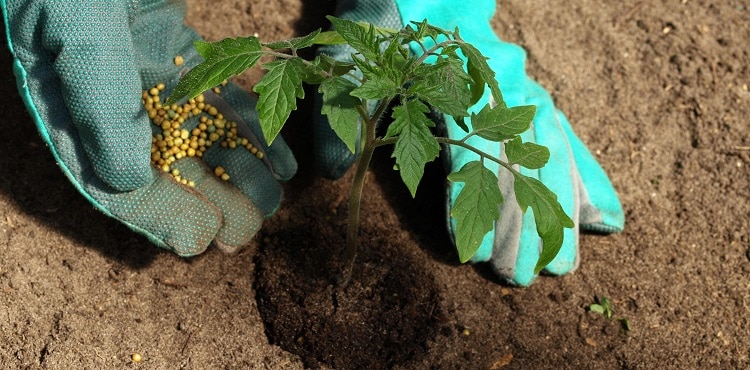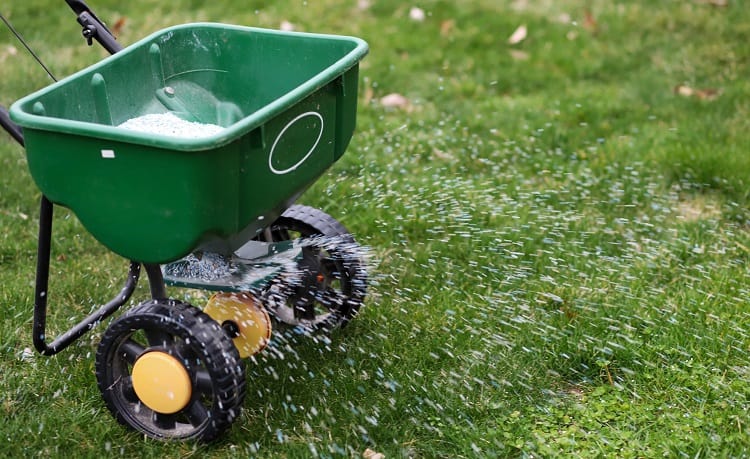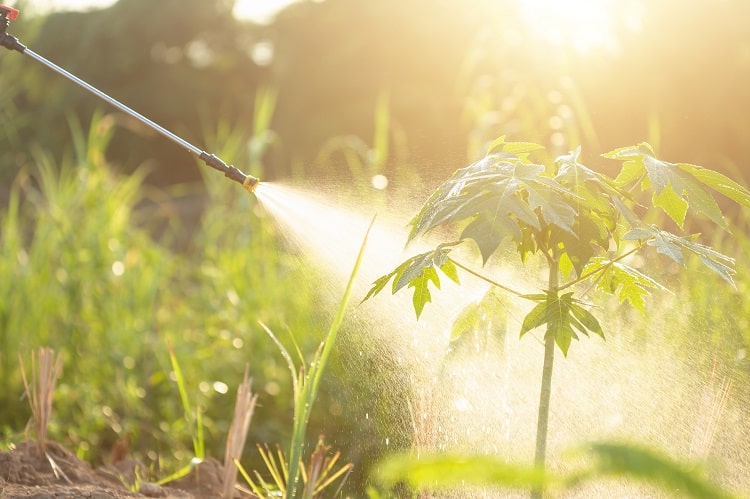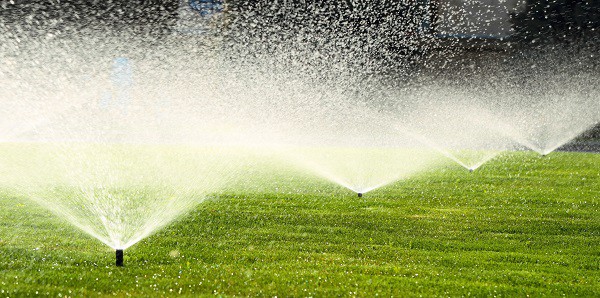If you are looking for something that will help your lawn grow lush and green or products that will help salvage dying grass, then you would undoubtedly come across fertilizers and lawn food. What is the difference between lawn food and fertilizer?
Fertilizers are products that provide your plants with the nutrients they need to grow and stay healthy. Lawn food is just how some manufacturers name their fertilizer products. Technically, plants make their own food, and the term plant food or lawn food refers to the nutrients that they use to manufacture their own nourishment.
I can see how people can be confused! But read on as I give you the low-down on fertilizers and lawn food.
What Is the Difference Between Lawn Food and Fertilizer?
In reality, plants make their food, but they need to have sufficient amounts of nutrients so that they can do so. The confusion between lawn food and fertilizer is that some manufacturers use them interchangeably.
To make it simpler, anything that you add to the soil or spray on your plants to make sure that they have the right levels of nutrients are fertilizers. Lawn food, or plant food, is produced by the plant or grass using the nutrients that they get from fertilizers or from the soil itself.
Lawn Food
Adding to the confusion are fertilizer manufacturers that call their products lawn food. Products on Amazon like the Scotts Turf Builder Lawn Food, Simple Lawn Solution’s Advanced 16-4-8 Balanced NPK Lawn Food Quality Liquid Fertilizer, and Miracle-Gro Water Soluble Lawn Food are very popular.
The use of the term “lawn food” makes you think that you’re giving your grass something to eat, the way you give dog food and scraps to a beloved Alaskan husky. The mental image of you providing your lawn a meal is further emphasized by the use of the term “feed.” Feed your lawn, like you would feed a pet.
However, a closer look at what these products contain will show you that it’s just fertilizer. For instance, Scotts Turf Builder Lawn Food plies the soil with nitrogen, potassium, sulfur, and iron.
It is these nutrients that allow the grass to create their own food, build strong and deep roots, and prime them to absorb nutrients better.
As such, a lot of people tend to use lawn food and fertilizers interchangeably. However, it’s really just the same thing.
Lawn Food vs. Fertilizer: When to Use What

If they are basically the same, should you prefer using fertilizers over products labeled as lawn food?
It all boils down on how knowledgeable you are with the nutrients that plants need for different things. Different plants and even different varieties of grass have different needs in various stages of growth.
So it’s all about formulations. For instance, if you’re just starting to grow grass for your lawn, you will need more phosphorus in your fertilizer. This nutrient makes roots grow in grass, according to this page. You will also need nitrogen to keep your grass healthy as it grows.
As such, you would want to use products that are specially formulated for new grass, such as the Scotts Turf Builder Starter Food for New Grass from Amazon. This product, which is labeled as lawn food, promises to make new grass grow 35 percent faster and 70 percent thicker compared to unfed grass. It can also help new grass have healthier and deeper roots.
Or you can buy something like GreenView’s Starter Fertilizer (also from Amazon). This product has nitrogen, phosphorus, sulfur, potassium, and chlorine, which are all beneficial to new grass. But what’s more, you can use this product not just to start your lawn, but also for newly planted trees, shrubs, evergreens, and other plants.
As the grass starts to sprout and grow, your lawn will need an extra dose of nitrogen. You can move away from starter fertilizers to regular ones that have a more balanced ratio of nutrients.
Check out products like the Lilly Miller All Purpose Planting and Growing Food (link to Amazon), which has equal amounts of nitrogen, potassium, and phosphorus. Or you can buy fertilizers that are specifically formulated for lawns, like The Andersons Super Juice All in One Soluble Supplement Lawn Fertilizer, which has a nitrogen, phosphorus, and potassium ration of 14-2-4. This gives your grass more nitrogen than any other nutrient.
When Should You Buy Lawn Food?
If you only have to care for your lawn and you don’t have a garden, then you should buy lawn food or fertilizer that are formulated for lawns. Lawn food is a fertilizer that is rich in nitrogen because that is what grasses need the most. It doesn’t have too much phosphorus in them because grasses do not have flowers or fruits, which are the main consumers of phosphorus.
Because these products are formulated for grass, you can be sure that each scoop you use is not wasted. And that it gives your lawn the nutrients that it needs.
Buying lawn food also helps you avoid putting too much phosphorus into the soil for your grass to absorb. Putting in too much phosphorus than what your lawn can use can cause water pollution if it gets into the groundwater.
There are currently 11 states that ban the use of fertilizers with phosphorus in it, including Minnesota, New York, Illinois, and New Jersey. So it might be illegal for you to buy anything other than lawn food or lawn fertilizer, depending on where you are.
When Should You Buy Fertilizer?
If you have other plants in your garden, then you might want to consider buying fertilizer. Using lawn food for other plants might kill it because of the high concentration of nitrogen in these products.
Plus, lawn food doesn’t have the other nutrients that are needed by other plants. This might result in your plants becoming weak, wilting, or not blooming, among other things. Dr. Earth Super Natural Liquid Lawn Fertilizer and similar products on Amazon might be perfect for your lawn, but not for your garden.
What’s more, some lawn food products have herbicides and pesticides that are mixed in to kill weeds and insects that can damage your lawn. These substances can be quite toxic to other plants. It kills weeds and the plants that you didn’t want it to kill.
Buying fertilizer can help you avoid all that.
Environmental Effects
When you use lawn food for your garden, the improper levels of nutrients will be a problem not only of your plants but also the environment. The effects will be similar to using too much fertilizer. For one, the extra nitrogen and phosphorus will get into surface water and then promote microorganism growth.
If it gets to larger bodies of water, such as lakes and oceans, the microorganisms will compete with the fish and other species for oxygen. The fishes will eventually lose and suffocate, killing them in the process. The dead fish will, in turn, degrade the quality of the water and will cause bad odors.
Algae and aquatic plants will flourish, and that is not a good thing. An overabundance of algae and other aquatic plants because they also deplete the oxygen. The algae also die, which fees the microorganisms in the water and contributes to the oxygen depletion.
If the nitrogen in the lawn food comes from ammonia or nitrates, that can make the water body toxic as well.
With all the environmental hazards that come from using the wrong kind of fertilizer for your garden, it helps to use lawn food only for your lawns where the grass can use all of it without having to worry about the extra nutrients that can get into the water table or nearby bodies of water.
How Do Plants Make Their Own Food?
Grass and other plants can make their own food if they have the following: chlorophyll, sunlight, water, and carbon dioxide. Water is absorbed through the roots and enters the leaves.
From there, the water gets into chloroplast cells that house chlorophyll, which is a green pigment that gives leaves their color. This green stuff absorbs sunlight and this triggers an important chemical reaction that starts a chain of processes that ultimately separates hydrogen and oxygen in the water.
The oxygen goes back into the air that we breathe while the hydrogen is used by the plant and turns it into carbohydrates.
Meanwhile, carbon dioxide enters the leaves via small pores on the underside called the stomata. The carbon dioxide is reduced to oxygen and carbon. The plant will expel oxygen while keeping the carbon, which it synthesizes with the hydrogen to make sugars and carbohydrates.
The Various Nutrients Needed for Plant Growth and Nutrition
As I have noted earlier, different plants and grass varieties have different needs. If you grow other types of plants and you want to save on fertilizers, you might be able to use the same products on both your lawns and your other plants. But to do this, you should know what nutrients are needed by your plants.
Every plant lover and gardener should know the different nutrients that plants need to sprout, grow, and bloom. There’s a lot, at least 16 nutrients are essential for your plant’s growth, according to this news story.
The three major nutrients, however, are nitrogen, potassium, and phosphorus. Nitrogen is a component of chlorophyll in plants, while plants need phosphorus to make food as it is required to form sugars, starches, and oils.
It’s also needed to convert solar energy to chemical energy and helps plants become stronger, as well as for rooting and blooming. Potassium, on the other hand, helps plants fight stress, especially if they have not been watered enough or during extreme temperatures.
| Nutrient | What It Does to Your Plants |
| Nitrogen | Greener and healthier leaves, chlorophyll production |
| Phosphorus | Fast-growing and healthy roots, stems, flowers, blossoms, and fruits |
| Potassium | Helps your plants make food |
Tip: I’ve written in-depth articles about why plants need nitrogen, phosphorus and potassium. Check them out!
Secondary Nutrients and Micronutrients
After the big three, these are also needed by plants:
- Calcium is an important part of the cell walls of your plants, as well as for transporting and retaining nutrients, which makes your plants hardier.
- Magnesium is needed for proper plant food production and growth.
- Sulfur is needed for your plants to produce protein, as well as for the development and activation of vitamins and enzymes. This nutrient also helps your plants to form chlorophyll and produce more roots and seeds, making it more resistant to cold.
- Boron helps regulate other nutrients taken up by your plants, as well as being necessary to produce carbohydrates, seeds, and fruits.
- Copper helps your plants reproduce and root.
- Chlorine regulates your plants’ metabolism and photosynthesis.
- Iron allows your plants to form chlorophyll.
Other nutrients necessary for healthy plants are manganese, molybdenum, zinc, and cobalt.
Why Do Plants Need Fertilizers, Anyway?
The good news is that most of the time, your lawn will be getting sustenance from the soil itself. Healthy soil will be able to provide the grass with the nutrients your lawn needs to survive. However, there are times when you will need to replenish or add to the nutrients that are already in the soil.
Plants need fertilizers to get the nutrients that they cannot get from the soil. Fertilizer products focus more on nitrogen, phosphorus, and potassium because these are the nutrients that plants need more.
Soil can get depleted. For instance, heavy rains or too much watering can move nitrogen, which moves freely in the soil. Fungi, viruses, and bacteria, along with other pathogenic microorganisms can also cause nutrients to get used up.
Soil exhaustion may also be a problem when it comes to lawns. With other plants, you can do some planting rotations, where you use the same soil for different types of plants to avoid depleting the same nutrients and maybe even give some of them back to the soil.
For instance, if you have just repotted a flowering plant or a fruit tree, you might want to plant legumes next to help the soil bounce back. You may not be able to do that with your lawn where it’s grass the whole year-round.
So instead of pulling out the grass and planting some other plant, you can just ply it with lawn food or fertilizer.
Fertilizing Your Lawn: More Tips

Aside from addressing the lack of nutrients for your lawn, there are also other things you might need consider.
1. When Do You Start on Your Lawn?
According to this article, the best time to fertilize your lawn is mid-April or when the soil temperature reaches 55 degrees Fahrenheit. This is the optimum temperature for grass to grow.
You can buy a soil thermometer to do the job. On Amazon you can get something like the Taylor Precision Products Soil Testing Thermometer that can measure the warmth of the soil two inches below the surface.
There are also digital versions that make it easier to take a reading. Or you can go high-tech and get a connected soil thermometer or hygrometer such as the SensorPush Wireless Thermometer and Hygrometer, which can also be found on Amazon. You can see the temperature and moisture readings on your smartphone, even if you’re more than 300 feet away from your lawn.
The best thing is that you don’t have to keep on checking. Once the sensor is connected to your device, it will automatically alert you if there are problems with your soil moisture or temperature. If you want to take it a step further, you can buy the optional Wi-Fi gateway that will allow you to connect your soil thermometer to the Internet and get alerts even when you’re halfway across the world.
2. What Is the NPK Ratio?
When you buy fertilizers, you will see three numbers on the packaging, such as 20 – 10 – 10. This is the NPK ratio and each number corresponds to nitrogen (N), phosphate (P), and potassium (K) respectively.
So an NPK ratio of 20 – 10 – 10 will mean that the bag of fertilizer has 20 percent nitrogen, 10 percent phosphate, and 10 percent potassium.
So that’s only 40 percent of the bag. The remaining 60 percent will be comprised of trace minerals and filler material that will guarantee that your fertilizer is evenly applied to your lawn to avoid over- or under-fertilizing your lawn.
Most of the time, you will need something with a lot of nitrogen in it. Because you’re not worrying about fruits and flowers, lawn food or fertilizers often do not have too much phosphorus.
3. Considering Using a Slow-Release Fertilizer
Lawn food such as the Milorganite Slow-Release Nitrogen Fertilizer on Amazon allows you to forget about nutrients in your lawn for weeks. These products break down the nitrogen, potassium, and phosphorus over six to 10 weeks, so you don’t have to apply and re-apply fertilizers every so often.
The thing is that your lawn will only need a 10th of a pound every week, or a total of two to three pounds of nitrogen throughout the season.
However, there are times when you would want to use lawn food that has fast-release nitrogen. According to the University of Illinois LawnTalk, fast-release nitrogen is better for quick remedies so that you can have your green lawn back in no time. It’s also a good way to remedy cold soil. Plus, they are affordable too.
Controlled-release fertilizers like granules, on the other hand, are very safe if you want to avoid burning your grass. It’s also less wasteful because you won’t lose it into the air or soil. But these products are more expensive than their fast-release counterparts.
Here’s a table of the advantages and disadvantages of both fast- and controlled-release fertilizers.
| Nitrogen Type | Advantages | Disadvantages |
| Fast-release nitrogen such as urea, ammonium nitrate, or ammonium sulfate | 1. Can turn your lawn green in no time 2. A quick remedy for when soils get cold 3. Most products are affordable | 1. Might cause too much growth in patches 2. More likely to burn the grass, causing it to turn brown 3. More likely that some of the nutrients are going to be lost into the soil or air |
| Controlled- or slow-release such as ureaform, sulfur-coated urea, activated sewage sludge, Isobutylidenediurea (IBDU), or water-insoluble nitrogen | 1. Grass grows more uniformly 2. Very unlikely to burn grass 3. Less likely to be lost through the air or soil | 1. May not work on cold soil 2. Most products are more expensive than fast-release varieties 3. May not see the quick color change in grass |
Source: LawnTalk – Lawn Care Info for Northern Illinois
Lawn Food: Granules or Spray?

There are two main kinds of lawn fertilizer: granules and spray. While spray fertilizers are quick and easy to apply, you may not have the right equipment for it. Plus you have to factor in the wind. You may not like the results where patches of your lawn are over-fertilized while others are not fertilized at all.
For a more even application, invest in a spreader and use granules. There are broadcast spreaders (link to Amazon) that allow you to just push it to spread the fertilizer and is great for working with bigger lawns.
There are also handheld spreaders on Amazon that you can use for a more efficient application while allowing you to get into narrower areas of your lawn.
4. Lawn Food: Schedule It Right
When feeding your lawn, timing helps a lot. Starting in mid-April, you should wait around four weeks or mid-May for the second application.
From then through October, you should feed your lawn every six to eight weeks, or longer, depending on the fertilizer that you use.
Further, you should continue fertilizing throughout the fall. During this time, the grass will need more potassium and phosphorus as it sends out roots deeper into the soil while also making itself stronger for the coming cold.
Buy something like Scotts Turf Builder WinterGuard Fall Lawn Food (link to Amazon), which can repair the damage that your grass sustained over the summer and making the roots grow stronger in preparation for winter.
Or get the GreenView 2129185 Fairway Formula Fall Fertilizer from Amazon, which has an NPK ratio of 30 – 0 – 12. As you can see, these products have higher potassium content while the nitrogen stays the same. Potassium helps plants and grass become more tolerant to extreme temperatures such as the intense heat during summer and the cold of winter.
Important Ratios to Look for
What NPK ratios should you be looking for? It depends on when you’re fertilizing.
| You are: | What your lawn needs | You can try (links to Amazon): |
| Starting a lawn | Needs more nitrogen and phosphorus to get the best growth and strong roots | Fertilome New Lawn Starter Fertilizer |
| Over the summer | More nitrogen to make your lawns green and thick, which shields the ground from the heat of the sun and prevents too much water evaporation. As such, thicker grass is more protected from heat and lack of water | Pennington 100536576 UltraGreen Lawn Fertilizer |
| For the colder month | More potassium for deeper roots, stronger grass, and better cold tolerance | Jonathan Green & Sons Inc (12414) Winter Survival Fall Fertilizer |
Your grass and your plants will need different levels of nutrients depending on the season. As you have seen, there are different types of lawn food depending on the season and climate.
In the spring, when plants are new, you’d need more nitrogen, which promotes stalk growth. As the seasons pass, plants need more phosphorus for stronger root systems and seed creation.
But what about the climate? If you live in areas that get more rainfall, you can use lawn food that has higher nitrogen content. If you do that during a hot spell or in warmer climates, the plants will grow more roots, which will make your grass thirstier.
The growth of new roots will also take the energy away from the top of your grass or plants, which will make it more susceptible to the heat.
Produce Magazine advised their readers not to fertilize during a heatwave. But if they do so, they might want to use liquid fertilizer or compost tea.
6. Watering Your Lawn and Fertilizer Use

Most people think that the more you water your lawn, the less you need to fertilize it. This is because they think that the grass is healthy as it grows faster and greener with more water.
However, the opposite is true: you need more fertilizer when you water more often. The grass will need more nutrients as it grows.
In fact, if you use an automatic sprinkling system, then you will need to add more fertilizer in about a month and a half. But if you don’t water daily, you can get away without adding more lawn food in two months. That’s two weeks of not minding the fertilizer and spreader.
Another thing about watering and fertilizers is to be sure that you read the label before you do anything. Some fertilizers need you to soak the lawn first before you apply. Granules on the other hand will need you to water the lawn after application because the moisture is necessary for these granules to break down and be useful to the soil.
Lawn Food vs. Fertilizer: Which Should You Use?
Too much of a good thing is almost always bad, and the same is true for nutrients for your lawn and plants. When to use lawn food vs. fertilizer, it’s always a good idea to get the right formulation for grass and plants. You can buy lawn food to ensure that you’re giving the grass the right levels of nitrogen and potassium.
Likewise, you can buy fertilizers for your plants to supplement them with the right amount of nutrients they need to grow, bloom, and be healthy.

